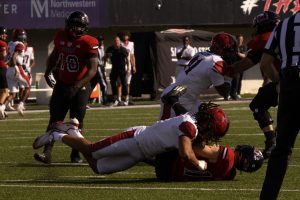ROTC trains at Miss. River
October 6, 1987
While the rest of campus was sleeping in late and/or recovering from Friday night’s festivities, about 104 NIU students were gathering in front of Stevenson Towers South early Saturday morning.
Some were there to help pay for their education. Others were there to train for a career. And others were there just to see what it was all about.
But they all had one thing in common—they were all members of the Reserve Officer Training Corps (ROTC) and heading out on a weekend Field Training Excercise (FTX).
By the time they returned Sunday afternoon, all the cadets had rapelled off cliffs, navigated with a compass during the day and night, maneuvered under simulated gunfire, set up ambushes and—for some—got their first taste of what it’s like to be a soldier.
uskie buses transported the cadets from NIU to Savanna Army Depot, near the Mississippi River, where they joined some of the senior cadets who had arrived a day earlier to set up training lanes and perform other support tasks.
After the buses dropped them off, senior cadets who act as officers in the ROTC battalion and were responsible for the planning and execution of this weekend’s FTX held a formation and issued the cadets their rations for the weekend—three MREs (Meal Ready to Eat). Each MRE comes in a brown plastic bag and consists of a main course, crackers and spread, some kind of fruit or vegetable item, candy, coffee, sugar, powdered creamer, two pieces of gum, a book of matches and a small package of blue toilet paper. Each cadet ate a MRE for every meal except dinner on Saturday, which consisted of hot dogs and hamburgers grilled over a charcoal fire.
After the cadets got their MREs, they set up their tents at a bivouac site using string to make sure that all the tents were lined up evenly.
Once that was done, the cadets broke down into their three companies and and began the day’s training in a round robin fashion, with each company spending about three hours at each of the three training sites.
Cadets crossed rope bridges and rapelled off cliffs that were 50 to 60 feet high at Mississippi Palisades State Park.
Many of the cadets had never rapelled before and Cadet Tonya Schafer said, “Once is enough in my lifetime …I’m afraid of heights.”
She said, “The first step was the worst,” and even after she had finished her descent she wasn’t sure if she was on the ground or not.
“I held on so tight—it was like my hands were frozen,” she said.
But not all the cadets shared her nervousness.
Cadet Robin Pandey said, “Once I was in the middle, it was fun. I started laughing and screaming.”
Mr. Robert Fausti, a NIU student and former Marine, supervised one of the rapelling lanes and offered encouragement and advice to one of the cadets by saying, “That rope’s the only thing between you and Jesus Christ right now—so hang on.” The cadet did as he was told and there were no injuries on either of the rapelling lanes.
At the land navigation site, cadets attended classes in land navigation and were tasked with finding four out of six markers by following azimuthes and distances provided to them by the senior cadets who were running the lanes.
Some of the cadets had problems in wooded areas because the terrain forced them to take smaller steps—causing them to misjudge their distance—and trees and bushes made it difficult for them to stay on the azimuthes they were given.
Most of the cadets finished the course—which was up to one-and-a-half kilometers long—within the 90-minute time limit.
The other training site—where the only serious injury occured—is where cadets learned how to move while under fire.
At this site, cadets learned how to low-crawl, high-crawl and do three- to five-second rushes. It was during one of these rushes that Cadet Chris Pagar said he, “just stood up and heard (his) knee pop.”
Fortunately for Pagar, NIU’s ROTC battalion includes Ben Schaefer, a Special Forces medic. Schaefer immobilzed Pagar’s dislocated knee and had him transported to Savanna City Hospital where Pagar sat out the rest of the FTX.
Saturday night after the cadets ate dinner, the battalion—not counting the Ranger team—was broken down into eight groups and transported in trucks to the land navigation site. Most of the cadets did not recognize the site, though, because it was dark and the trucks took a roundabout way to confuse the cadets. Once there, the groups departed in 15-minute intervals. Using land navigation skills, the cadets headed out to set up ambushes.
Cadet Scott Bybee said, “I was real impressed with my group. Most of them had never done anything like this before—but they were still quiet and didn’t move once I placed them. … They (other cadets) walked right into our ambush.”
Since the cadets did not have real weapons that fire blanks—the ambushes were sprung by cadets yelling, “bang, bang, bang!”
Once this was done, all the groups headed back to the bivouac site while trying to avoid a couple of cadets whose job it was to catch them as they tried to return.
One cadet managed to capture five groups within a matter of minutes. Two other groups were called in once the five were captured, and the eighth group could not complete the assignment in the time they were allotted.
It was now about 11 p.m. and the cadets headed back to their bivouac site for hot soup and a warm sleeping bag.
The Rangers stayed out almost all night though. Under the guidance of Mr. Fausti—who went through U.S. ARMY Ranger school as a Marine—the cadets set up a patrol base and ran patrols almost the entire night. They got about an hour-and-a-half of sleep that night.
In the morning the cadets went to whichever training site they did not go to the previous day.
Once all the companies had gone to all the sites, the cadets broke down their bivouac site, did a few push-ups and had an informal formation where they were told about the advantages of joining the National Guard and Reserves.
National Guard Recruiters drove the trucks the cadets were transported in and they used that opportunity to try and convince young ROTC cadets to join.
Sgt. Herb Kaelin, who is a recruiter in Sycamore, has been coming out with the cadets for about three years. He said he’s had “lots of success” recruiting ROTC cadets. He said the main reason most people, including cadets, join is the benefits.
Members of the National Guard are entitled to free tuition at any state school once they have been in for a year and completed their training. They are also eligible for the new G.I. Bill which gives them $140 for every month they are a full-time student. In addition to that, National Guard members get about $100 per month just for showing up and training one weekend a month, he said.
Kaelin said that many cadets are attracted to the guard because the guard goes out and trains in the field—using real weapons and tactics—nine weekends a year (winter drills are usually spent in armories) and two weeks in the summer.
Captain Harold Anson of the NIU military science department doesn’t mind the National Guard trying to recruit cadets. “They’ve got a helluva program for money,” he said.
“We offer about 40 scholarships (that pay tuition) a year … but Illinois is unique with its National Guard Scholarship program,” Anson said.
e also said that cadets who are also members of the National Guard or Army Reserve receive more training than cadets who just train with ROTC. “That puts them ahead of a lot of other cadets when they go to Advance Camp,” he said.






